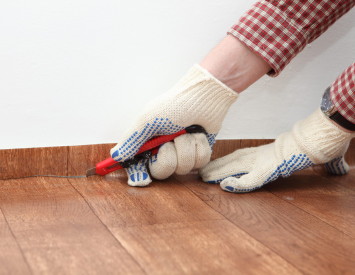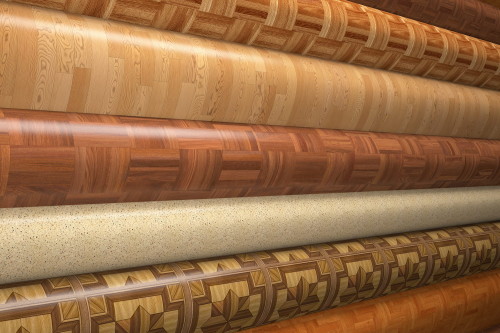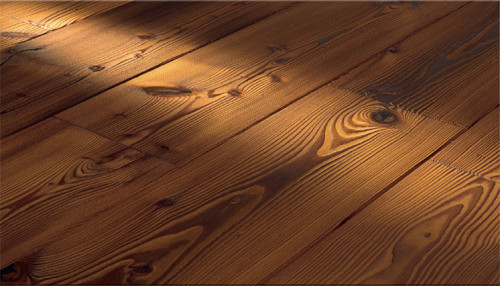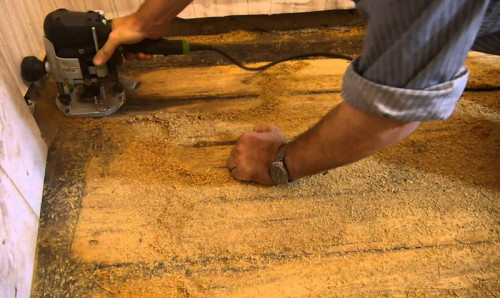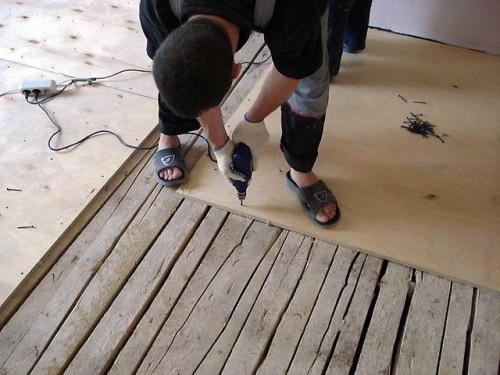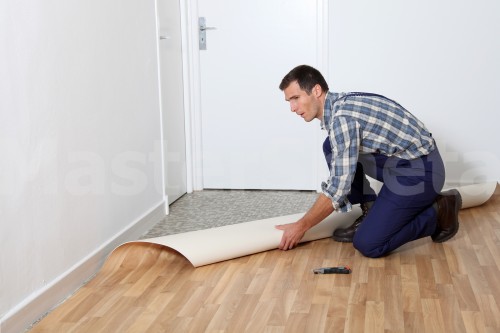Among all types of flooring, linoleum is very popular. It is durable, wear -resistant, hygienic, environmentally friendly and relatively inexpensive. Modern manufacturers offer us the widest selection of shades and textures of such a coating, including options that simulate parquet, laminate and other materials. In this article we will talk about the types and features of linoleum, as well as how to properly lay it on the floor.
Content
Features and types of linoleum
Such a flooring is good in that you can always choose an option that is optimally appropriate for the interior. It is worth noting that modern production technologies make it possible to create very high -quality and outwardly attractive material. For example, linoleum with imitation of a laminate is often practically not distinguished from a real laminated board. But it costs noticeably cheaper, it fits easier, and care for it is not difficult.
The advantages of linoleum include not only an affordable price and simplicity of washing, but also resistance to abrasion, water resistance, environmental friendliness, resistance to temperature changes and ultraviolet light. Such a coating is not afraid of mold and fungi, pests do not start in it.
You can lay linoleum on almost any base, the main thing is that it is carefully prepared. The surface on which laying is carried out should be even, clean and dry. When it comes to wood, you will have to get rid of all ledges and cracks, as well as to close the cracks between the boards. If this is not done, an elastic roll material repeats the shape of all the shortcomings on the surface.
Before laying linoleum on the wooden floor yourself, you should decide which material should be purchased. To do this, you need to familiarize yourself with the varieties of the flooring:
- PVC-linoleum is made of polymer raw materials. It can be single -layer or multi -layer. Multilayer material, in addition to the front side, has a fainted, tissue or heat -insulating substrate. A foamed coating consists of 4 layers. Among its advantages, good sound and heat-insulating properties, high strength, and long service life can be distinguished. The disadvantages include insufficient flexibility. Such material is used in rooms with a high level of humidity and with a large cross -country ability. Linoleum on a tissue basis is two -layer. In terms of its heat -insulating and noise -protective properties, it is inferior to the previous option, but it is distinguished by good elasticity and strength. The coating on the heat -insulating substrate includes a felt layer or a base of foamed synthetic material. The easiest and cheapest look is linoleum without a substrate. It has a homogeneous structure, among the advantages, elasticity, water resistance, and strength can be distinguished.
- Alkyd coating is made of alkyd resins with the addition of mineral fillers. As a rule, such linoleum has a substrate of natural or synthetic raw materials. A distinctive feature of the alkyd coating is low elasticity, which is why it can crack or break.
- Rubber linoleum consists of rubber. The upper layer is decorative, has a beautiful shade or pattern. A mixture of bitumen and crushed rubber waste acts as a substrate. The pluses include plasticity, water resistance, resistance to abrasion. Most often, this material is used in industries and industrial facilities.
- Colloxyl linoleum is made of nitrocellulose. It is quite elastic, not a fuel, has a beautiful glossy surface.
All types of linoleum are presented on sale with a wide range of shades and drawings. A protective film is applied on top of the decorative layer on linoleum, the strength of the material depends on the thickness of which. The more wear -resistant the coating is, the wider the scope of its use.
Lining linoleum on a wooden floor with your own hands
Assessment of wood
The installation of linoleum on a wooden floor always begins with an assessment of the condition of the working surface. It is on this that the need for preparatory work depends. To begin with, you need to go vigorously on a wooden floor or even run. A reliable base will not creak or bend underfoot.
The second step needs to assess the condition of the boards, which is determined by their color. Healthy wood has a uniform natural shade without darkening. If there are still dark spots on the surface, try to pierce them with an awl or screwdriver. The metal will enter the rotten wood easily, and the healthy will be solid and strong.
There should not be spots of mold or fungus on the wooden floor, and the nails that are nailed should not be rusty. It is especially important to check the base for the presence of rot before laying linoleum on a wooden floor of the balcony.
It is worth evaluating the floor and for the presence of insect pests. If bugs are started in the wood, you will find the grooves that they have eaten on the surface. Having found rotten or trapped boards, they should be replaced with new elements, and in the case of bugs, the floor will also require processing by bio -protective equipment.
When assessing the state of the floor, lift a couple of boards and look at their inside, and also pay attention to the lags. Like the boards themselves, they should not be moldy or ridiculous.
The wooden floor should also not bend underfoot. If this happens, then the lags do not withstand the load and need to strengthen. The coating can creak in the case when the boards rub against each other. Such a problem will help to solve talc, covered in the gap.
Using a building level, it is necessary to check the horizontal surface. Having completed all the recommendations, you will get a beautiful and neat coating.
Necessary materials and devices
To cover the wooden floor with linoleum, you need to prepare materials and tools:
- toothed spatula;
- knife;
- roller;
- glue or bilateral tape;
- a ruler with a length of at least 2 m;
- nails;
- cold welding if you connect the joints of the sheets in this way;
- wood putty;
- sheets of plywood, wooden bars, screws and other devices for leveling the floor surface;
- cycle machine.
Preparation of the floor for work
The technology of flooring with linoleum provides for the preparation of a working basis. If the surface is even and does not creak, then such work will take a minimum amount of time. You will need to remove the remains of the old coating from the floor, drowning the hats of nails in wood.
All minor defects are easiest to be torn by a cycle machine or a simple shirt. After you remove the upper layer of wood along with minor roughnesses, smear the gap and cracks with putty, as well as those places where the nails are driven. For this work, you will need a wood putty. If the floor is not aligned, then defects can be noticeable on the surface of linoleum, which will ruin its aesthetics.
If the changes in the heights of the working base are quite noticeable, then the simple cycle machine will not cope with them. Before laying linoleum on an uneven floor, it needs to be leveled. We describe the 2 of the most common ways:
- The first method involves the use of a self -leveling mixture. Such a mixture is poured onto the floor with a continuous layer and distributed on the surface. She covers all the cracks and protrusions, creating a horizontal surface. It is worth noting that for a wooden floor, a similar method of leveling is not considered optimal, but if you decide to use this method, then purchase a special mixture for wood.
- A more demanded method for leveling a plank base involves the use of sheet material, for example, plywood, wood-bruise, organ, furniture shields, etc. To begin with, such sheets are laid on the floor, after covering their inside and boards with parquet glue or a mixture of gypsum and PVA. After the glue hardening, the sheets are fixed with nails or brackets. If the changes in the heights of the draft floor are significant, then at first the lags are laid on it in the form of bars, adjusting them to the horizontal level. Then they lay the sheets on these lags. The seams between fragments are covered with putty, and after its drying, the entire surface is impregnated with olipois.
The final stage of preparatory work is the purification of the base from garbage and dust. Linoleum can only be laid on a clean and dry floor.
Preparation and laying of the material
Before laying linoleum on a wooden floor, you need to calculate the required amount of material. The calculation is made, having previously measured the area of \u200b\u200bthe room and adding 10-15 cm to the received numbers. If a repeating pattern is applied to the material, then you need to purchase 1 row of linoleum more from each side. It is worth taking into account the temperature shrinkage, for example, for PVC it \u200b\u200bis 2%.
If you want to lay linoleum on the wooden floor with your own hands, be careful when transporting the material. It cannot be greatly bend to avoid the formation of creases. When you bring the sheets to the place, put them in the room and level them from the center to the walls. Leave in this form for 2 days. If there are waves and bubbles on the surface, crush them with something heavy.
Fractures and bends strongly spoil the appearance of the coating, if such defects are significant and it will not work to hide them during the repair process, it is better to change the entire roll. You can work with linoleum at a temperature of at least 16 ° C and humidity level from 40% to 60%.
It is best to spread plain material in the direction of daylight in order to hide the joints between the sheets. The seams must be placed on the middle of the boards.
Excessive shortcuts are cut along the edges of the room so that gaps are left near the walls at 0.5-3 cm. They will allow the material to expand under the influence of heat, but will not be noticeable, since they will close with skirting boards. Where pipes come out of the floor, there are protrusions or something similar, the coating will have to be cut in the appropriate form. To do this, marking it with a pencil or pen, then cuts with a knife and cut out.
In small rooms, a meter of not more than 12 m² of linoleum can not be glued to the floor at all. It is laid around the entire perimeter and fixed with skirting boards and threshold.
In rooms with a larger area, the material is attached to the surface with glue or bilateral tape. Scotch tape can be glued both along the entire inner surface of the material and along the perimeter of sheets. Fixation with glue is considered the most reliable, although the work itself will require more time and effort. In large rooms with an area of \u200b\u200b20 m², only this styling method is acceptable.
Having glued linoleum on a wooden floor, they go along it with a roller or rink. It will take 7-10 days to dry the glue, during which it is better not to move around the room. Fragments of the material glue overlapping, then cut two layers of material at the junction and apply cold welding to the seam.
